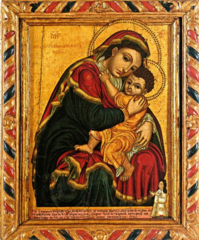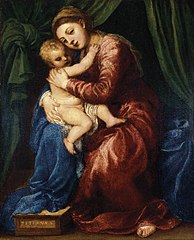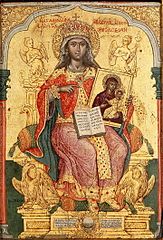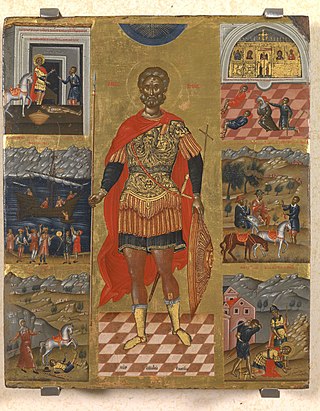
Cretan school describes an important school of icon painting, under the umbrella of post-Byzantine art, which flourished while Crete was under Venetian rule during the late Middle Ages, reaching its climax after the fall of Constantinople, becoming the central force in Greek painting during the 15th, 16th and 17th centuries. The Cretan artists developed a particular style of painting under the influence of both Eastern and Western artistic traditions and movements; the most famous product of the school, El Greco, was the most successful of the many artists who tried to build a career in Western Europe, and also the one who left the Byzantine style farthest behind him in his later career.

The Heptanese school of painting succeeded the Cretan school as the leading school of Greek post-Byzantine painting after Crete fell to the Ottomans in 1669. Like the Cretan school, it combined Byzantine traditions with an increasing Western European artistic influence and also saw the first significant depiction of secular subjects. The school was based in the Ionian Islands, which were not part of Ottoman Greece, from the middle of the 17th century until the middle of the 19th century. The center of Greek art migrated urgently to the Ionian Islands but countless Greek artists were influenced by the school including the ones living throughout the Greek communities in the Ottoman Empire and elsewhere in the world.

Emmanuel Tzanes, also known as BounialisEmmanuel Tzane-Bounialis, Emmanuel Zane, and Emmanuel Tzane, was a Greek Renaissance painter, author, clergyman, and educator. He spent the latter half of his life in Venice, where he was parish priest of the church of San Giorgio dei Greci and a member of the Flanginian School run by the city's Greek Confraternity. Tzanes painted in the style of the Cretan School, influenced by contemporary trends in Venetian painting. His known extant works, over 130 in number, can be found in public foundations, private collections, churches and monasteries in Greece. The most popular of these is The Holy Towel, finished in 1659. Tzanes was a collaborator with Philotheos Skoufos, and brothers with the painter Konstantinos Tzanes and the poet Marinos Tzanes.

Theodore Poulakis was a Greek Renaissance painter and teacher. He is considered the father of the Heptanese School and one of the most prolific painters of Venetian Crete. Poulakis was a member of the Cretan School, his contemporary was Emmanuel Tzanes. Emmanuel Tzanes and Poulakis were active painters of the Cretan School until Candia, went to war with the Ottomans around 1649. Candia finally fell after twenty years of siege in 1669. Poulakis settled on the island of Corfu. Stephanos Tzangarolas was another famous painter in Corfu around the same period. Poulakis's works are likened to Andreas Pavias and Georgios Klontzas. Poulakis works exhibit qualities of the Venetian school. Over 130 of his paintings have survived and can be found all over the world.

Georgios Klontzas also known as George Klontzas and Zorzi Cloza dito Cristianopullo, was a scholar, painter, and manuscript illuminator. He is one of the most influential artists of the post-Byzantine period. He defined the Cretan Renaissance. His artistic output included icons, miniatures, triptychs and illuminated manuscripts, commissioned by both Catholic and Orthodox patrons. He is known for occupying his icons with countless figures. The technique is extremely complex and unique to Klontzas. Andreas Pavias attempted this technique in the Crucifixion of Jesus. Klontzas's painting All Creation rejoices in thee is his most popular work. Klontzas influenced Theodore Poulakis he created an extremely similar painting called In Thee Rejoiceth. Klontzas's work is strongly influenced by the Venetian school. His triptychs strongly resemble the works of Gentile da Fabriano, namely the Intercession Altarpiece. Klontzas's Last Judgement resembles Michelangelo's Last Judgement in the Sistine Chapel. There are very close similarities. There is no indication that Klontzas saw the work but it is a possibility. According to the Institute of Neohellenic Research fifty-four items of his art exist today.

Frantzeskos or Franghias Kavertzas was a Greek painter. His painting style resembles the late Cretan School or early Greek Baroque period. His work was influenced by Georgios Klontzas, Michael Damaskinos and Emmanuel Tzanfournaris. He was active in Crete during the early part of the 17th century roughly after the death of Georgios Klontzas. He painted two icons that are very similar to Klontzas's most notable pieces. Theodore Poulakis also painted similar themes. Kavertzas artwork incorporates the Venetian school. His works influenced Leos Moskos. His most notable works are the Last Judgement, In You Rejoiceth.

Leo or Leos Moskos was a painter and educator. There were two other painters named Moskos active around the same period, Elias Moskos and Ioannis Moskos, who may have been his relatives. Indeed, Leo is often confused with Elias Moskos. Some of his work was inspired by Georgios Klontzas and Franghias Kavertzas. He traveled all over the Venetian Empire. Records indicate he traveled to Venice, Cephalonia, and Zakynthos His style resembled the Cretan School. He taught famous painter Panagiotis Doxaras. His most popular work is the Last Judgment. His paintings can be found all over the world. Twenty of his paintings have survived.

Stephanos Tzangarolas also known as Stephano Tzangarola. He was a Greek painter during the late Cretan Renaissance. He migrated from Crete to the island of Corfu. He is a member of the Heptanese School and the Cretan Renaissance. His contemporaries at the time were Panagiotis Doxaras, Theodore Poulakis and Elias Moskos. His artwork began to reflect the transition of the classical maniera greca of Crete to the more refined style of the Ionian Islands. His style resembles the transition of Gentile da Fabriano and Fra Angelico from the maniera greca to their respective styles. Tzangarolas paintings influenced countless artists both Italian and Greek. Some artists that reflect his style include Spyridon Sperantzas and Georgios Kastrofylakas. His paintings can be found all over Greece mainly Athens and the Ionian Islands. Some of his work is in Cairo and London. His student was famous Greek painter Andreas Karantinos.

Emmanuel Skordilis, also known as Emmanouil Skordilis. He was a Greek Renaissance painter. He was active in Crete around the time Emmanuel Tzanes, Elias Moskos, and Philotheos Skoufos were painting in Crete. He belongs to the elite group of Greek painters that followed the Venetian influenced maniera greca in Crete. Sixty eight of his works survived. He is one of few artists to not travel to the Ionian Islands and participate in the Heptanese School. He eventually settled in the Cyclades on the inland of Milos. Christodoulos Kalergis is another prominent Greek artist associated with the Cyclades, he was from Mykonos. Skordilis was influenced by Georgios Klontzas, Michael Damaskinos and Angelos. Skordilis brought the artistic style of Crete to the Cyclades and influenced countless artists in that region.

Ioannis Tzen also known as Ioannis Dzenos, was a 17th-century Greek baroque painter. He was active on the Ionian islands and a prominent member of the local school. He also represented Crete towards the end of the Cretan School. His painting style reflects an affiliation with Emmanuel Tzanes. He was active on the island Corfu. Greek painters affiliated with the same island active during the same period were Theodore Poulakis, Stephanos Tzangarolas. Fifteen of his works have survived. His most notable work is a painting of the Virgin and Child.

In Thee Rejoiceth also known as Epi Si Harri is a tempera and gold leaf painting by Georgios Klontzas. The painting is a tribute to the Virgin Mary. Klontzas was active on the island of Crete during the second half of the 16th century. He was a member of the Cretan School. He was one of the most prolific Greek painters of the 16th century. Most of his works were copied by other artists. The In Thee Rejoiceth painting was copied by countless Greek and Italian painters. Theodore Poulakis created a version in the 17 century that is very similar to Klontzas's In Thee Rejoiceth. Franghias Kavertzas also painted a similar theme. He called his painting In You Rejoices. Leos Moskos also created his version of the popular painting. The Klontzas painting is currently at the Hellenic Institute of Byzantine and Post-Byzantine Studies Museum in Venice.

In Thee Rejoiceth also known as Epi Si Harri is a tempera and gold leaf painting by Theodore Poulakis. The central figure of the piece is the Virgin Mary. The painting is a tribute to her. Poulakis was from Chania Crete. He was active on the Ionian islands and in Venice during the second half of the 17th century. He was a member of the Cretan school and the father of the Heptanese (Ionian) school. According to the Institute of Neohellenic Research, 130 paintings are attributed to Poulakis.

In You Rejoiceth also known as Epi Si Harri is a tempera and gold leaf painting by Francheskos Kavertzas. The painting is a tribute to the Virgin Mary. Kavertzas was active on the island of Crete during the first half of the 17th century. He was a member of the late Cretan School. Seven of his works survived, five were signed. His two most notable pieces are The Last Judgment and In You Rejoiceth. The theme and style behind In You Rejoiceth mostly resembles Georgios Klontzas's painting In Thee Rejoiceth. Theodore Poulakis also created his own version of the masterpiece In Thee Rejoiceth towards the second half of the 17th century. Many artists created their own version of the painting. The theme became a prototype in Crete during the 17th century. Leos Moskos also created his own version of the painting. The Klontzas and Poulakis paintings both feature the Hymn to the Virgin. The Kavertzas painting lacks the pictorial representation of the Hymn to the Virgin. The name is used on paintings that are stylistically similar to Klontzas's original work. Francheskos Kavertzas painting is located in Paris at the Musée des beaux-arts de la ville de Paris.

The Last Judgment also known as The Second Coming is an egg tempera painting by Francheskos Kavertzas. His artistic period was during the first part of the 17th century. Seven of his works survived, five were signed. He was a member of the late Cretan School. The Last Judgment painted by Georgios Klontzas inspired countless Cretan artists, Kavertzas was one of them. Kavertzas's painting In You Rejoiceth strongly resembles Klontzas's In Thee Rejoiceth. Leos Moskos was also inspired by Klontzas's work. He also painted a similar version of The Last Judgment. The final judgment is the last judgment of every person on earth. The painting is a pictural representation of that event. The Kavertzas The Last Judgment is unique because it features a nun. Her name was Evgenia Trapezontiopoulla. According to records on March 9, 1641, the nun could not afford to pay for the painting. Kavertzas and the nun bartered instead. The painting is part of the collection of the Hellenic Institute of Venice in Italy.

Lady the Lambovitissa is a tempera painting by Emmanuel Tzanes. Tzanes was a Greek painter active from 1625 to 1690. His artistic periods can be broken into three parts. The Cretan Period (1625-1647), The Corfu Period (1647-1655), and the Venetian Period (1655-1690). He was a prominent member of the Late Cretan School. His art was heavily influenced by Greek painter Michael Damaskinos. His brothers Marinos Tzanes and Konstantinos Tzanes were both painters. Tzanes has a massive art collection attributed to him nearing over one hundred thirty works. During the Corfu Period (1647-1655), Konstantinos Tzanes and Emmanuel were heavily active. They painted many works on the island.
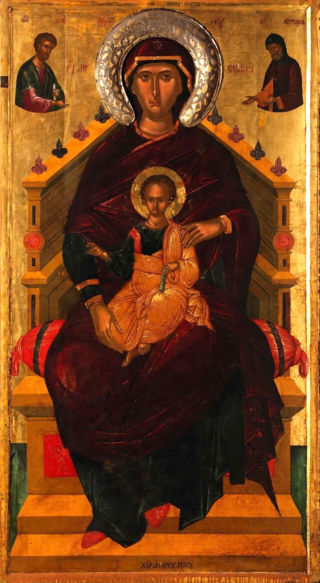
The Virgin Pantanassa is a tempera painting by Andreas Ritzos. Ritzos was a Greek painter active on the island of Crete. He flourished from 1435 to 1492. The painter has an existing catalog of over sixty works attributed to him. He signed his works in both Greek and Latin. He is one of the most influential painters of the Cretan Renaissance. He painted in the traditional Greek-Italian Byzantine style. His work was also heavily influenced by Venetian painting. His teacher was Angelos Akotantos. He was also affiliated with Andreas Pavias. His son was famous Greek painter Nikolaos Ritzos. Ritzo's Italian contemporaries were Paolo Uccello and Fra Angelico. They all painted a mixture of the Greek-Italian Byzantine and Italian Renaissance styles. The art of Crete was heavily influenced by the founder of the Venetian school Paolo Veneziano.

Virgin Glykofilousa is an egg tempera painting by Andreas Karadinos. Karadinos was a Greek painter active from 1680 to 1740. He was a prominent member of the Heptanese school and a representative of the island of Kefalonia. His teacher was famous painter Stephanos Tzangarolas. Karadinos was an Archpresbyter. He was active during the Neo-Hellenikos Diafotismos and Greek Rococo period. One fresco and twenty-two of his paintings have survived. He was also a goldsmith. A unique inscription on a holy table at the church of Agios Spyridon in Kefalonia features important details about his life.

The Virgin and Child on Bronze is an egg tempera painting by Greek painter Elias Moskos. Moskos was originally from Crete. The painter migrated to Zakinthos. Two other painters with the name Moskos were active during his lifetime. They were Ioannis Moskos and Leos Moskos. All three painters were affiliated with Venice. Fifty-two of Elias's paintings survived. It is difficult to characterize the work of some painters belonging to the late Cretan School. Some artists also belong to the Heptanese School. The technical migration from the maniera Greca of Cretan-Venetian painting to the more refined Ionian-Venetian style is visible in the works of Elias Moskos and Theodoros Poulakis. His painting of the Virgin and Child drastically migrates from the traditional mannerism prevalent in Cretan painting. The painting clearly belongs to the Heptanese School. His painting of the Virgin and Child is at the Benaki Museum in Athens Greece.

Assumption of Mary was a painting created by Greek painter Nikolaos Doxaras. He was the son of famous Greek painter Panagiotis Doxaras. Nikolaos flourished on the Ionian Islands. He was a representative of the Heptanese School. He traveled all of the Ionian Islands painting. He spent close to a decade in Venice. He had a relationship with Johann Schulenberg. Doxaras stayed with him from 1730 to 1738 at the Palazzo Loredan. He was his confidant at the Schulenburg Art Gallery. He also painted for Schulenburg. He left Venice and continued painting all over the Ionian islands until his death. He was active from 1725 to 1775. Five of his paintings survived. Both Nikolaos and his father attempted to popularize oil painting.

The Virgin and Child Enthroned is a tempera painting created by Spyridon Romas. He was a Greek painter from the island of Corfu and a prominent member of the Heptanese School active from 1745 to 1786 in Corfu, Lecce, Livorno, and London. Twenty-five of his works survived according to research completed by the Hellenic Institute. One of few Greek painters that changed his style completely Romas transitioned from the Heptanese School to the British style of painting. He traveled to London, England around 1770, and remained in the country until his death. Romas painted several portraits but also maintained art. An important iconostasis containing most of his works is preserved in Livorno, Italy at the Museo della Città di Livorno.


